Fast Facts
- When: 10th to 17th November 2024
- Where: Pala Alpitor, Turin, Italy
- Watch: Amazon Prime
- Official Website: Nitto ATP World Tour Finals
The ATP World Tour Finals is, as the name suggests, a tournament held at the end of the ATP World Tour season. Held each year in November, in Turin between 2021 and 2025, it is played indoors on hard courts. And, with only the top 8 players (according to ATP rankings) participating, it’s high octane tennis from start to finish.
The format for the ATP Finals is different to most tennis tournaments in that there are two groups of four players, with the contestants in each group playing each other once. The top two from each group progress to the semi-finals with the winners of the semis going on to the final. The matches are all best of three sets with tie-breaks played at 6-6, even in the deciding set.
Existing Customer Free Bets & Money Back Offers
Note: Offers will appear here nearer the event as and when they become available.
Event Stats
ATP World Tour Finals 2023 Lineup
| Ranking | Player | Points | 2023 Titles | 2023 Prize Money | Group |
|---|---|---|---|---|---|
| 1 | Novak Djokovic | 9,945 | 6 | $11,524,597 | Green |
| 2 | Carlos Alcaraz | 8,455 | 6 | $9,647,931 | Red |
| 3 | Daniil Medvedev | 7,200 | 5 | $8,134,179 | Red |
| 4 | Jannik Sinner | 5,490 | 4 | $5,697,879 | Green |
| 5 | Andrey Rublev | 4,805 | 2 | $4,795,071 | Red |
| 6 | Stefanos Tsitsipas | 4,235 | 1 | $4,460,015 | Green |
| 7 | Alexander Zverev | 3,585 | 2 | $3,715,164 | Red |
| 8 | Holger Rune | 3,460 | 1 | $3,425,919 | Green |
Schedule
- Round Robin Group Stage: Sunday 10th to Friday 15th November 2024
- Semi Finals: Saturday 16th November 2024
- Final: Sunday 17th November 2024
About The ATP World Tour Finals
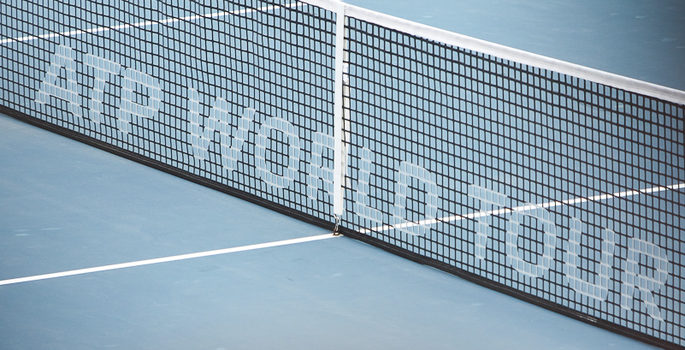
The ATP is the Association of Tennis Professionals, formed in 1972 in order to protect the interests of the players in the days before such things were really taken into account. It was the idea of Donald Dell, Bob Briner, Jack Kramer, and Cliff Drysdale and the organisation has been responsible for the running of the men’s tour since 1990. It is the male equivalent to the Women’s Tennis Association (WTA), which is, as the name suggests, responsible for the women’s game.
The History of the Tournament
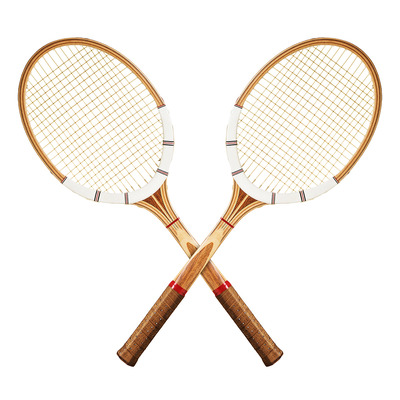
Though the ATP didn’t take over the men’s tour until 1990, a competition that developed into the ATP World Tour Finals had been in existence since 1970. Originally it was known as the Masters Grand Prix and was one of the events that were part of the Gran Prix Tennis Circuit. The International Lawn Tennis Federation were responsible for it back then and was rivalled by the World Championship Tennis Tour’s WCT Finals.
The Masters was originally formed as a showpiece event that didn’t count towards a player’s world ranking points but saw the best players on the men’s tour go head-to-head. When the Association of Tennis Professionals took over the event in 1990 they renamed it as the ATP Tour World Championship and ranking points were available to the competitors. If a champion went through the tournament unbeaten then they’d be rewarded with the same number of ranking points as if they’d won one of the Grand Slams.
The International Tennis Federation might have lost the right to run the competition, but they didn’t have to take that lying down. As a consequence, the ITF came up with their own event that was designed to rival the ATP Tour World Championship, known as the Grand Slam Cup. That was competed over by the sixteen players who had done the best in the various Grand Slam events over the year. The split of the best players into two separate competitions meant that neither of them were considered to be all that prestigious, leading to the two organisations to discontinue their events in favour of a joint one that became known as the Tennis Masters Cup.
The Masters Cup became the ATP World Tour Finals in 2009 and changed venue to the O2 in London. In 2017 it enjoyed another name change, becoming the ATP Finals and the contract with the O2 was extended to 2020. Prior to its arrival in London in 2009 it was played at different locations around the world, with a mix of indoor and outdoor venues being common depending on the location chosen. It was an outdoor event in 1974 when it was based in Melbourne, Australia, for example, as well as in 2003 and 2004 when it was hosted by Houston in the US. In 2021 the finals switched to Italy, playing at Turin’s Pala Altipour indoor arena until 2025.
World Tour Finals Venue History
| Years Held | City | Country | Surface |
|---|---|---|---|
| 2021 – 2025 | Turin | Italy | Hard Court (Indoor) |
| 2009 – 2020 | London | England | Hard Court (Indoor) |
| 2005 – 2008 | Shanghai | China | Carpet & Hard Court (Indoor) |
| 2003 – 2004 | Houston | USA | Hard Court (Outdoor) |
| 2002 | Shanghai | China | Hard Court (Indoor) |
| 2001 | Sydney | Australia | Hard Court (Indoor) |
| 2000 | Lisbon | Portugal | Hard Court (Indoor) |
| 1996 – 1999 | Hanover | Germany | Carpet & Hard Court (Indoor) |
| 1990 – 1995 | Frankfurt | Germany | Carpet |
| 1977 – 1989 | New York | USA | Carpet |
| 1976 | Houston | USA | Carpet |
| 1975 | Stockholm | Sweden | Carpet |
| 1974 | Melbourne | Australia | Grass |
| 1973 | Boston | USA | Carpet |
| 1972 | Barcelona | Spain | Carpet |
| 1971 | Paris | France | Carpet |
| 1970 | Tokyo | Japan | Carpet |
To date, the competition has taken place in sixteen different venues since it was established in 1970 and played in the Tokyo Metropolitan Gymnasium. Some of the more exciting and interesting venues used include Madison Square Garden, Hanover fairground in Germany and Shanghai’s Qizhong City Arena. It is considered by many to be the most important and illustrious indoor tennis tournament in the sporting calendar.
About the O2 Arena (Hosted 2009 – 2020)

As with any venue, where the ATP Finals are held is relevant when it comes to trying to figure out who is likely to be crowned the victor. The North Greenwich Arena, which is better known nowadays as The O2 Arena because of sponsorship, was opened in 2007. It was built underneath the Millennium Dome after it became clear that the Millennium Experience was something of a white elephant. Instead it was decided that an entertainment complex and arena would be built, with construction beginning in 2003 and taking four years to complete.
Interestingly, it was impossible for cranes to be used underneath the Dome and so the roof of the arena was actually built on the floor before being hoisted into position. The rest of the building was then constructed around the roof, with the final result taking up forty percent of the space underneath the Dome. As with the Manchester Arena in the North of England, the entire seating structure of the Dome can be altered and the surface can change depending on what is being hosted there. As well as tennis, the Arena has been used as a venue for basketball, ice hockey, music events and conferences.
The reason the venue matters is because of the surface that players are asked to use when they arrive for the ATP Finals. In the past, for example, the ATP Finals have been played on a carpet surface that is something of a leveller on account of the fact that so few players will have played on it before. At the 02 the organisers used a surface called GreenSet, which is an acrylic hard court. The International Tennis Federation, Association of Tennis Professionals and the Women’s Tennis association all approve of this type of surface. It’s also used at the Paris Masters, Swiss Indoor Championship and the Open Sud de France, to name but three.
Where the ATP World Tour Finals Fits in the Tennis Calendar
There are 7 event categories in total in the men’s game, with each offering a certain amount in prize money and world ranking points on offer. Here’s a look at each of them, including the governing body responsible for them:
ATP Tournament Details (2024 Season)
| Event Category | Events | Max Ranking Points |
|---|---|---|
| ATP World Tour Finals | 1 | 1,500 |
| Grand Slam (ITF) | 4 | 2,000 |
| ATP Masters 1000 | 9 | 1000 |
| ATP 500 series | 13 | 500 |
| ATP 250 Series | 38 | 250 |
| ATP Challenger Tour | 184 | 80 to 125 |
| ITF Men’s Circuit | 550 | 18 to 35 |
With over 800 events held every year, the range of events is vast on the ATP these days. The majority of these events are via the ITF Men’s Circuit, which is basically the lowest ranking events that you can get on the professional scene. These players are generally younger and trying to make their way up the world rankings by hoovering up the points that those more experienced players aren’t interested in.
The more prestigious events start with the ATP World Series, ranging from the those offering two hundred and fifty ranking points right the way up to those with a thousand points on offer. These events will often feature the top ranked players in the world and it gives players a chance to break through into the top fifty players in the world. Those that manage to do so are then able to secure automatic places within the Majors and other ranking events.
As you can see from the table above, the prize money drastically increases for the events that offer the most ranking points, with most tournaments seeing a huge chunk of the overall prize money being given to first place.
Whilst the Grand Slam events are the pinnacle of the sport for any tennis player, the ATP World Tour Finals is often regarded as the ‘5th major’. The week-long tournament includes the top eight ranked players in the world and with it comes a massive prize pool of $15,000,000 in 2023. An undefeated winner of the singles will be looking at a Cheque worth upwards of $4.8 million, almost rivalling that of most of the Grand Slam events.
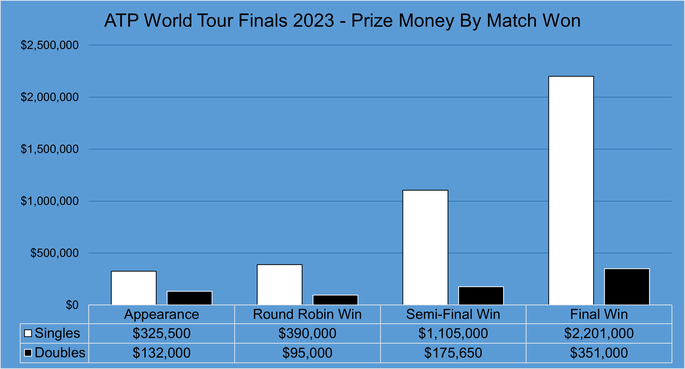
Format
The ATP Finals feature the top eight Singles players and the top eight Doubles teams according to the ATP Rankings. The nature of the tournament and the fact that it was originally intended to be something of a showpiece event means that it differs from every other Singles event on the men’s tour in that it’s not a knockout competition. Instead, the eight participants are split into two different groups of four and the players go head-to-head in a round-robin format.
At the end of the round-robin stage the two players from each group that have performed the best advance to the semi-finals and the winners of the two semis then meet each other in the final. There have only been six occasions since the tournament was first introduced that this round-robin group format has not been used. In 1970 and 1971 there was a round-robin stage but the winner was the player who had performed best. From 1982 until 1984 there were twelve players who went up against each other in a knockout format, then in 1985 sixteen players played knockout tournament tennis.
Ranking Points
As mentioned before, the ATP Finals offers the same sort of prestige in terms of prize money as one of the four Majors. It also offers players a chance to boost their ATP Ranking Points, as the graph below demonstrates:
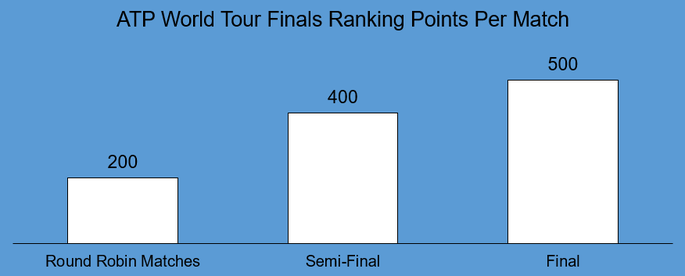
The above figures are accurate for the 2023 iteration of the tournament. Players start with the potential of winning 1500 Ranking Points and drop 200 every time they lose a match in the round-robin format. It’s possible for a player to lose two matches at that stage and still go on to win the tournament overall, but that hasn’t happened at the time of writing.
Sponsorship
As well as the changes in the prize money involved in the ATP Finals over the years, the competition has also enjoyed numerous different sponsors since it was introduced. When it changed hands to become part of the Association of Tennis Professionals’s roster in 1990, however, the idea of a sponsor was dropped.
The competition as a whole remained without a sponsor until 2009, at which point Barclays Plc came on board as the main sponsor. That deal remained in place until 2017, when a Japanese company named Nitto Denko took over responsibilities. The tournament as a whole might not have enjoyed a main sponsor but individual sections of it still did, such as IBM’s decision to sponsor the Singles competition.
Interesting Facts
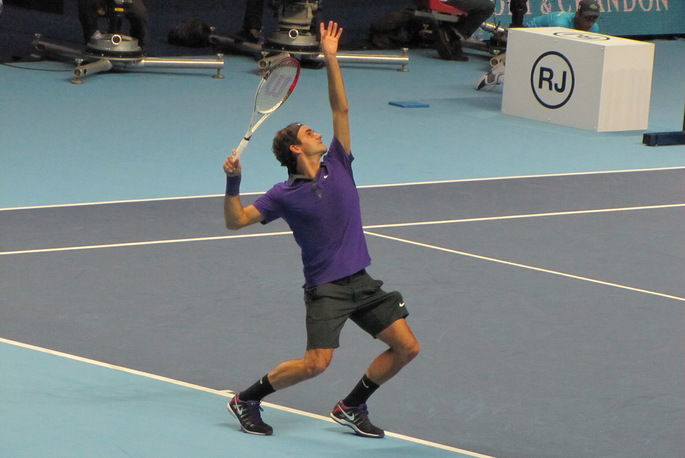
The series as a whole, including the days dating back to 1970 when it was known as the Masters Grand Prix, has plenty of interesting facts associated with it. Here’s a look at some of them:
- Novak Djokovic is the most successful player in the event winning on seven occasions, one more than Roger Federer with six
- Roger Federer holds the record of 17 appearances in the Finals, one ahead Novak Djokovic on 16
- Other notable winners with five victories in total are Ivan Lendl and Pete Sampras
- The most successful Doubles pairing was Peter Fleming and John McEnroe, with seven wins to their name as partners
- What’s probably most incredible about their success is that all seven wins came in consecutive years from 1978 through to 1984
- The next most successful Doubles pairing are Bob and Mike Bryan, who have won alongside each other on four different occasions, with Mike ahead by one title winning five in total
- Daniel Nestor has also won the Doubles tournament four times, doing so with three different partners
